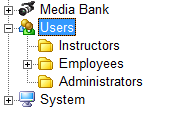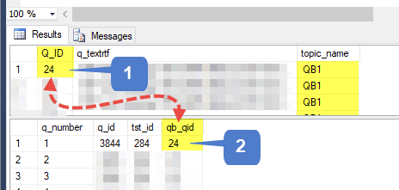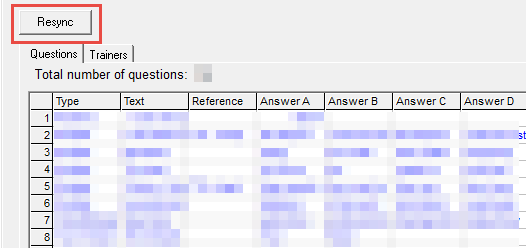Background

Test administrators are referred to as "t.admins“. Instructors, trainers and teachers are grouped together as "instructor-level users" or "t.authors". Anyone taking tests: employees, pre-hires, trainees, students or customers are "t.takers". Question banks are "qbanks" and questions, "items".
This guide is intended for t.admins and instructor-level users who have...

- Participated in one or more online training sessions...
- An intermediate to advanced knowledge of Test Generator and TG Reports...
- Created and populated question banks with items...
- Created tests by importing items from one or more qbanks.
 Best Practices
Best Practices
- In order for the Resync feature to work, always begin by creating qbanks and populating them with questions.
- Before importing items into a question bank, we highly recommend reviewing the items for technical accuracy, spelling and grammar.
- Peer Review: It never hurts to have more than one set of eyes review the questions. If you already have an established set of review policies, congratulations. Peer review can help reduce or eliminate a "garbage-in-garbage-out" cycle that can lead to problems later on.
- For a more detailed review of the topic, we recommend, "A Guide to Better Test Making".
- Don't do anything until you have participated in an online training session, or received instructions from a team member who has received training. There are many features that you may not be familiar with; features that can save you time and effort and make your use of TG more productive.
- Don't enroll any instructor-level user in a qbank without providing them with training and a clear set of guidelines regarding the management of a qbank. Reason: mistakenly modifying, and then re-syncing, qbank items could result in data corruption. See "Changes Allowed" and "Changes NOT Allowed", below for more details. If you are not sure how to proceed, please contact us before attempting any re-syncing.
 QBank Permissions
QBank Permissions
Test administrators (t.admins) can create qbanks and add items to them. Qbanks can consist of one, "root" bank, or a root bank and one or more nested sub-banks. The tier1 administrator can create tier2 admin-level users, and any t.admin can create, and add items to a qbank. Also, any t.admin can create instructor-level user profiles and enroll them in one or more qbanks. Any instructor-level user enrolled in a qbank at the root level, is also given access to the sub-banks nested under the root bank. T.admins and qbank-enrolled instructor-level users can manually type in questions or import them from a TG-friendly, .csv, .txt, .xls or .xml file.
 QBank Parameters
QBank Parameters
 Question Bank Q_ID and Test Question QB_QID
Question Bank Q_ID and Test Question QB_QID
TG assigns a unique ID number to items in a qbank. This number is stored in the item's Q_ID data field.
The number is not visible to the t.admin.
When a t.admin creates a test and imports items from a qbank into a test, the Q_ID number is copied into the test item’s QB_QID data field. A correspondence is created between the qbank item’s Q_ID number and the test item’s QB_QID number. Below is an image displaying the results of two queries. The top portion [1] displays the qbank query results, and the bottom portion [2] displays the results of an item query. If you would like a copy of the query, please contact us.

Question bank items can exist in various tests and tests can be organized under more than one course. As long as the test items are exported from a qbank into a test, the qbank item’s Q_ID number will match the test item’s QB_QID number and resyncing is possible.
Resync Scenario
The Resync feature enables t.authors to modify/update items from the question bank to any test that contains a copy of the qbank item. Reasons for modifying items may range from test takers identifying "bad" items to a t.admin's analysis of test data. Who, what and why changes are made to qbank items is a decision that is best left to the t.admin, peer evaluators and/or management. We recognize that policies and guidelines range from comprehensive to non-existent. To avoid data corruption and test data analysis issues later on we recommend that you not use the Resync features without having a review plan in place.

Changes: Allowed
- Spelling, syntax or grammatical errors in the question stem, answers or question feedback text.
- Changes in policies and procedures that result in changes to the question stem, test introduction of individual question instructions.
- Regulatory changes requiring changes to the question reference field, custom fields, or journal entries in a question’s Notes field.
- Text formatting changes
Changes: NOT Allowed
- Changing an incorrectly marked answer from, for example, “B” to "D"
- Changing item point values
- Changing incorrect feedback
- Changing randomized answer settings
- Enabling or disabling partial scoring
- Enabling or disabling the Allow Partial Credit – Individually Scored setting
- Adding or removing an Incorrect Points value
- Changing Media or the media link
Test Generator does not prevent the t.author from making these changes; however, once made there is no Undo option.
Applying any of the "NOT Allowed" settings to q.bank items--and then re-syncing them--will lead to corrupted test data. This applies to any test that...
- Contains test data (scores) and
- One or more re-synced questions and
- Remains active and available to your t.takers
The t.author would end up with two sets of data that do not match.

Set_1 consisting of test data before the resync change, and
Set_2 consisting of test data after the resync change
Does this matter? Yes, it matters if your organization is...
- Subject to a state, federal or professional licensing audit of your test data.
- Intent on maintain a healthy testing system with accurate data.
- Providing high-stakes testing that influences hiring / firing decisions, promotions or security clearances.
- Dedicated to providing your test-taking audience with a quality testing experience.

![]() Best Practices
Best Practices![]() QBank Permissions
QBank Permissions

